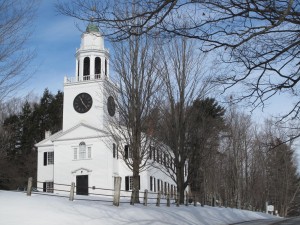
Church on the Hill Burying Ground
Lenox received three acres for a burying ground in 1770 and the first burial took place the following year. The Church on the Hill Cemetery (at the intersection of Main and Greenwood Streets, adjoining the Church on the Hill), is a typical Colonial burying ground–close to the meetinghouse with single graves in rows. According to several recorders of early history, children played in the graveyard area during breaks in the long, long services and sheep grazed to keep the grass down.
Traditionally, in colonial burials, the deceased were buried with their feet to the east so that as the day of judgement dawned they could sit up and face the rising sun. The earliest gravestones show evidence of the Puritan reminders that life was brief and grim with skulls or crossed bones. As time went on, gravestone imagery shifted more toward mourning and loss with weeping willows, cherubs or vases of flowers.
Historically, people died at home and pall bearers came to carry the deceased to the cemetery. Church bells rang to announce the death of a fellow resident. Although the mourners might ride horseback, hearses were not common until the mid 19th century. Until that time, pall bearers would, in relays, carry the deceased on planks. It was considered a breech of decorum if the pall bearers did not take a drink before heading for the cemetery. Men and women generally approached the grave separately. Black, as it is today, was the color of mourning, but it is unlikely that ordinary citizens could afford to be dressed entirely in black in the early days of the town.
Death in the first year of life was far more common than it is today. People were also more likely than they are today to die in the prime of life from
- accidents (particularly ensuing infections)
- pneumonia
- tuberculosis
- cholera (there was a major epidemic in the 1830’s)
- typhoid
- childbirth.
Cancer, heart disease and strokes were not as common in the 19th century as they are today — probably because fewer adults lived into their 70’s and because hard physical labor formed an important part of many people’s lives.
Smallpox had been a major killer until after the Revolutionary War when inoculation became common.
Until the Massachusetts state constitution changed in the 1830’s, local taxes contributed to the support of the “state” church — the Congregational Church. Consequently, the cemetery associated with Lenox’s Congregational Church, the Church on the Hill at 169 Main St., was also the town cemetery. When local receipts no longer went to support the church, the Church on the Hill cemetery became a town cemetery as it is today.
Although in the last 50 years most burials have been moved to other town cemeteries, the Church on the Hill cemetery is a reflection of the town’s history with veterans of all wars, families whose names have come and gone, and names that still prominent in Lenox.
You are encouraged to explore this interesting historic site, but we ask that you not bring pets, climb on the stones or take rubbings.

What a beautiful church!
I had no idea there was so much history to this church. We have been to Lenox many times and never knew about this place.